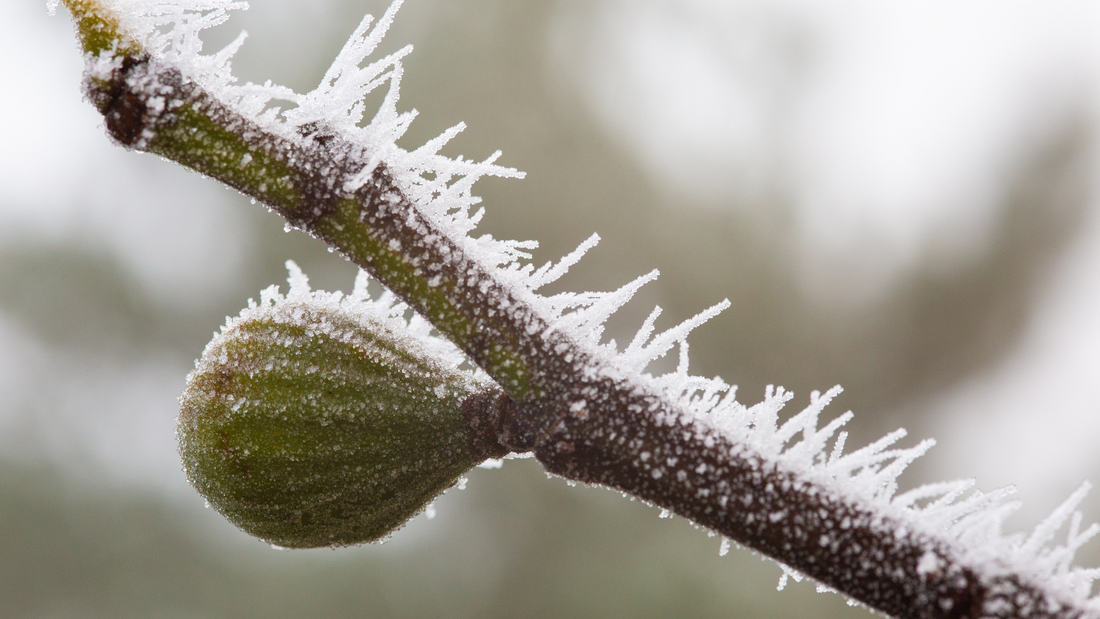As the winter chill approaches, many fig tree collectors and enthusiasts find themselves contemplating the best techniques to protect their beloved fig trees during the harsh winter conditions. In this blog we'll delve into winter care considerations for both potted and in-ground fig trees. We'll share our experiences in south Georgia and explain different ways you can protect fig trees.
How Cold Can Fig Trees Take?
Our winters in south Georgia aren't extremely cold, so it's tough for me to test the limits of cold-tolerance for specific fig varieties. But I can share my experiences with the cold anomalies we get. Last year (2022) we dealt with the "Arctic Blast" right before Christmas, which brought a low of 17°F and below freezing temperatures for several days.
This Arctic Blast was the first time we had ever seen any damage on our in-ground fig trees. We lost a couple 1 year old fig trees that had just been planted the previous spring. The cold temperatures burnt them to the ground and they didn't recover the following year.
Most of our older, in-ground trees were fine. A few of these 4-5 year old fig trees had a limb or two that was damaged by the cold, but there was no significant damage on the older trees. All of them produced very well for us the following spring.
Given this information, I can conclude that young in-ground trees are definitely in danger when temperatures drop below 20°F. You'll want to consider covering these young trees to protect them on nights when temperatures start to get in the low 20s.
I can't tell you what kind of temperatures it takes to significantly damage a larger in-ground tree, because our fig orchard has never experienced temperatures that low. It's definitely lower than 17°F, but not sure of the exact threshold. My guess is that you'd start seeing more significant damage with temperatures in the low teens and single digits.

Should You Protect Fig Trees in the Winter?
I know some growers that go to extreme lengths to protect their fig trees during the winter. I know other growers that just let their fig trees die back to the ground each winter and recover in the spring. I recall talking to some growers from Tennessee at a recent fig convention, and they said their trees will die back to the ground and regrow each year.
Fig trees are tough and will recover even after a tough winter. But maybe you'd like to preserve some growth from one year to the next, which would give you a chance at more new growth and more figs to harvest. If that's the case, you probably will want to protect your trees.

Protecting Potted Fig Trees
There are a couple options with potted fig trees. If you have plenty of room indoors and want to allow your fig tree to continue to grow throughout the winter, move it inside before your first frost and that will prevent the tree from going dormant. Just be sure you have enough space to deal with an ever-growing fig tree.
If you're limited on indoor space for your potted fig tree, you'll want to let it go dormant by experiencing your first frost outside. Once the first frost causes the tree to drop leaves and go dormant, prune it to an acceptable size and move it to a garage or other cool spot.
If you keep it in a really warm spot, it might break dormancy and want to start growing again. Ideally you'll want to keep it dormant until your weather warms again in spring. A garage or storage building would be a great place for it, making sure you cover it with a blanket if outside temperatures get in the low teens or single digits.

Protecting In-Ground Fig Trees
There are various strategies for protecting in-ground fig trees, with some being more exhaustive than others. The first step in protecting an in-ground fig tree is to prune it to a manageable shape and size. It won't hurt the tree to prune it back to a few limbs, so do whatever you need to make it easier to wrap or protect.
Many fig tree growers will simply wrap the limbs with foam pipe insulation. As mentioned above, this is much easier if the tree is pruned to a few limbs. The more limbs and branches you have, the longer it's going to take to wrap.
Other growers will go a step above simple foam insulation and wrap the fig tree to protect it. They'll use string or rope to bundle the branches of the tree tightly, then wrap the tree in tar paper, burlap, or some other breathable fabric. They'll then wrap the tree with a tarp or canvas and put a bucket on top of the wrapped tree.
I've also seen growers add mulch or leaves into the cylinder created by the tree wrapping. This serves to further insulate the in-ground fig tree during the winter. It's hard to say how many degrees of protection each layer provides, but you can get as crazy as you like with it.

Better Safe Than Sorry!
If you live in zones 8 and 9, you probably don't need to worry about protecting fig trees unless they were recently planted. If you live in zone 10, it likely never gets cold enough to damage a fig tree.
For in-ground fig trees, zones 7 and above would have cause for concern during certain winter cold spells. I recommend planning ahead for these situations so that you're not scrambling to protect your tree at the last minute. Have a plan so that you can preserve the aboveground growth you have.
Don't be left wishing you would have done something to protect your fig tree. It's better to be safe than sorry. If you think your fig tree could be compromised, go ahead and protect it.

